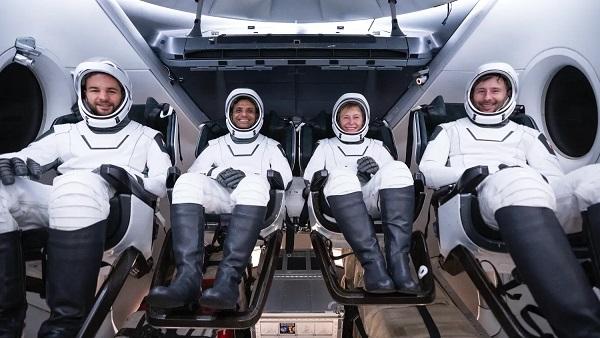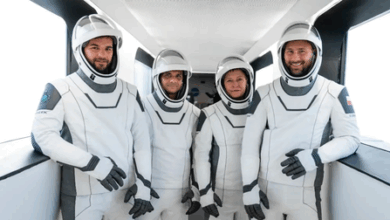
India stands on the cusp of a transformative milestone in its space journey. Axiom Mission 4 (Ax-4), the fourth private astronaut mission to the International Space Station (ISS), is more than a commercial endeavor—it represents a bold step into the future of international collaboration, scientific exploration, and commercial human spaceflight. Spearheaded by Axiom Space in collaboration with SpaceX and NASA, this mission exemplifies how private spaceflight is expanding access to orbit while strengthening India’s role in this emerging frontier.
A Historic Liftoff at a Historic Pad:
Scheduled for launch on Wednesday, June 11, for the launch of its Axiom Mission 4 (Ax-4) to the International Space Station (ISS). The launch is scheduled for 8:00 a.m. ET from Launch Complex 39A at NASA’s Kennedy Space Center in Florida, utilizing a Falcon 9 rocket. Should the primary launch opportunity on Wednesday be scrubbed for any reason, a backup launch window is available on Thursday, June 12, at 7:37 a.m. ET. Ax-4 will lift off aboard a SpaceX Falcon 9 rocket, carrying the Crew Dragon C213 Scheduled for launch on. This pad is steeped in history—it previously launched the Apollo missions and Space Shuttle flights—and now marks the next chapter in human spaceflight. After a 28-hour orbital chase, the capsule will dock with the ISS on June 11, initiating a 14-day research-intensive stay in microgravity.
A Crew of Nations: India Takes the Spotlight:
Ax-4 features a four-member multinational crew, including notable representation from India. The mission is commanded by Peggy Whitson, a former NASA astronaut and the most experienced American in space, now Director of Human Spaceflight at Axiom. But for India, all eyes are on Group Captain Shubhanshu Shukla, a distinguished officer from the Indian Air Force, selected as one of the astronauts under ISRO’s human spaceflight program, Gaganyaan. He is set to become the first Indian to visit the ISS, and only the second Indian national to travel to space, after Rakesh Sharma’s historic flight in 1984.
Shukla’s journey is more than symbolic—it’s strategically significant. It provides critical real-world experience in crew operations, space health monitoring, and long-duration mission protocols. This exposure will benefit ISRO as it prepares for future indigenous missions and increases its stake in the global space ecosystem.
The rest of the Ax-4 crew includes Mission Specialist Tibor Kapu from Hungary, representing his nation’s first government-backed space mission since the early 1980s, and Mission Specialist Sławosz Uznański-Wiśniewski from Poland, an ESA astronaut and the first Polish national in space in nearly five decades.
Science in Orbit-Pioneering Experiments with Indian Contributions:
Ax-4 is more than a human spaceflight; it is a floating laboratory conducting over 60 science experiments and technology demonstrations, making it the most ambitious Axiom mission to date. These span human health, biological science, materials research, Earth observation, and in-space manufacturing. India’s contribution is unique and meaningful. Shubhanshu Shukla will conduct space nutrition experiments, jointly developed by ISRO and the Department of Biotechnology (DBT) in collaboration with NASA. These studies aim to assess the viability of sprouting Indian food staples—like methi (fenugreek) and moong (green gram)—in microgravity. Success here could pave the way for sustainable food production for long-duration missions to the Moon, Mars, and beyond.
Additionally, Shukla will participate in five human research studies conducted by NASA. These include physiological assessments related to muscle loss, cartilage degeneration, cognitive changes, immune system adaptation, and cerebral blood flow—all crucial for understanding the effects of long-duration spaceflight on the human body.
Expanding Frontiers in Science and Innovation:
The mission’s broad research portfolio includes,
Human Research: Effects of computer screen exposure in microgravity, cognitive and neuroimaging studies, blood flow patterns, joint and muscle condition monitoring, gut microbiome studies, and use of electrical stimulation to prevent muscle degradation.
Life Sciences and Biology: Growth and stress responses of microalgae, cyanobacteria, and fruit flies, focusing on radiation resistance and genetics. Studies also investigate stem cell aging, cancer development, and organ-on-chip drug testing in orbit.
Agriculture in Space:
Plant germination and growth of microgreens, paving the way for future bioregenerative life support systems.
Materials Science and Earth Observation:
Heat dissipation in space suits, next-gen materials testing, and Earth observation for environmental monitoring.
These experiments will provide key data for the future of sustainable space living and advance our understanding of life sciences beyond Earth.
Beyond the Mission – Toward a Commercial Space Future:
Ax-4 is not an isolated initiative; it is part of Axiom Space’s long-term goal of building the world’s first commercial space station, set to succeed the ISS by the end of this decade. By showcasing the feasibility of private, multinational space missions, Axiom is laying the foundation for an ecosystem where governments, private entities, and international agencies can collaborate in orbit.
For India, Ax-4 is a strategic inflection point. It signals a shift from a government-dominated space model to active commercial engagement, allowing India to integrate more deeply into the global space economy. It also builds trust and credibility for future ISRO missions, particularly in human spaceflight and international partnerships.
India’s Rising Star in Orbit:
Axiom Mission 4 is a milestone not just for commercial spaceflight but for India’s emergence as a leading spacefaring nation. With the presence of Group Captain Shubhanshu Shukla aboard, India is no longer a bystander—it is a central participant in shaping the future of space exploration. This mission underscores a bold vision: a future where India helps lead humanity’s quest beyond Earth, blending science, diplomacy, and innovation in orbit.











